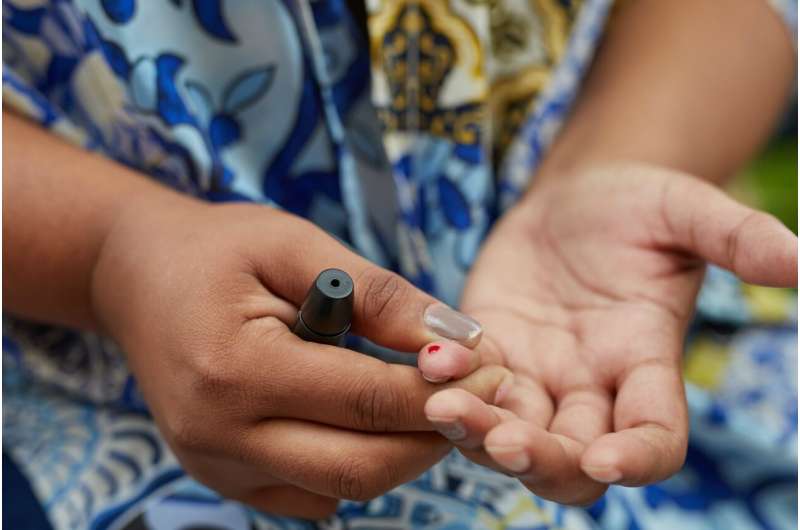This article has been reviewed according to Science X's editorial process and policies. Editors have highlighted the following attributes while ensuring the content's credibility:
fact-checked
trusted source
proofread
Metabolic signature can help predict which smokers will develop type 2 diabetes

New research being presented at this year's Annual Meeting of The European Association for the Study of Diabetes (EASD) in Hamburg (2–6 Oct) finds that cigarette smoking increases the risk of developing type 2 diabetes in part by affecting a variety of metabolites—small chemicals produced in the processes of metabolism—that circulate in the bloodstream.
The influence of these metabolic changes on diabetes risk appears to be amplified in individuals with genetic susceptibility to type 2 diabetes or insulin resistance.
The analysis of over 93,000 UK Biobank participants also identified a metabolic signature of 131 metabolic traits that can help predict which smokers are more likely to develop type 2 diabetes.
"Our metabolism is constantly changing depending on what we ingest or are exposed to," says lead author Yuxia Wei from the Karolinska Institutet in Sweden. "Our study is the first to develop a metabolic signature for smoking based on comprehensive metabolomic profiles, and provides new insights into how smoking influences certain metabolites to increase the risk of type 2 diabetes. The findings underscore the importance of refraining from or quitting smoking to prevent diabetes, particularly for individuals with genetic risk factors for diabetes who seem to be more vulnerable to these changes."
Previous observational evidence suggests that smokers are 20-60% more likely to develop type 2 diabetes, but the underlying mechanisms are unclear.
To address this knowledge gap, researchers used nuclear magnetic resonance spectroscopy (NMR) to analyze hundreds of metabolites in blood samples from 93,722 never, former, and current smokers (aged 37-73 years) without diabetes at the start of the study (2006-2010) from the UK biobank—which holds genetic, health, and medical information from approximately half a million British volunteers. Metabolomics data were collected again in 2012-2013.
During an average (median) follow-up of 13 years, 1,869 new cases of diabetes were identified.
The observational analysis and causal relationship analysis identified 131 metabolites affected by smoking, including glycoprotein acetyls (an inflammatory biomarker), fatty acids, and lipids, which collectively indicated whether an individual would go on to develop type 2 diabetes.
Compared with effects in people who never smoked, current smoking increased the risk of type 2 diabetes by 73%; and 38% of this excess risk was mediated through the smoking-related metabolic signature (44% in men and 30% in women), after accounting for traditional diabetes risk factors such as age, sex, education level, ethnicity, BMI, physical activity, diet, and family history of diabetes.
For free fatty acids, smoking seemed to lead to higher levels of unhealthy saturated and monosaturated fatty acids, and lower percentages of healthy polyunsaturated ones such as DHA, omega-6 fatty acids, and omega-3 fatty acids (mainly found in seafood). Smoking was also positively associated with metabolites including different lipids in very-low-density lipoproteins (VLDL), triglycerides, and LDL cholesterol (also called "bad" cholesterol), and lower levels of all forms of HDL cholesterol (often known as good cholesterol).
Importantly, the findings indicate that most of the smoking-related metabolic changes are reversible after quitting smoking.
The analysis additionally found that a high level of the metabolic signature was associated with a 61% higher risk of developing type 2 diabetes compared to a low level.
Genetic susceptibility also made a difference. Individuals with both a high level of the metabolic signature and a high genetic susceptibility to type 2 diabetes were three times as likely to develop the condition as those with low levels of the signature and genetic susceptibility.
The interaction between genetic susceptibility and the metabolic signature enhances their overall impact on type 2 diabetes. As Wei explains, "The excess risk of developing type 2 diabetes in people with both a high genetic susceptibility and a high level of the signature surpasses what we would expect by simply adding the excess risk in people with only a high genetic susceptibility and the excess risk in people with only a high level of the signature. Our findings suggest that it is even more important for people with high genetic susceptibility to avoid smoking than the general population."
The researchers further tested and verified the metabolic signature in blood samples from 3,626 participants in the TwinGene Study, a cohort nested in the Swedish Twin Register. They noted that the ability for the metabolic signature to determine risk of type 2 diabetes was highly reproducible despite the fact that individuals living in the UK and Sweden have different dietary habits, lifestyles, and environmental exposures.
"The reproducibility of the findings in the Swedish population indicate the robustness of the approach," says Wei. "Nevertheless, more than half of the smoking-diabetes link was not explained by the metabolic signature, suggesting that other pathophysiological consequences of smoking play a role in diabetes development. These mechanisms may include the adverse effects of smoking on pancreatic tissue and beta cell function."
Despite the important findings, the researchers note several limitations of the study, including that smoking status and metabolite levels may have changed during follow-up, which may have influenced the results; and that the study was conducted in people mainly of European origin, so the findings may not be generalizable to other populations.



















